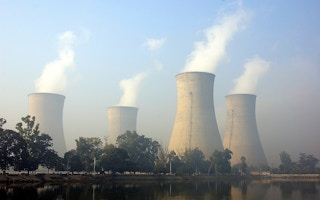From research scientists to political organisers, people around the planet are working to thwart a threat whose scale has become increasingly clear: Global heating is spurring a climate crisis of megafires, superstorms and record-setting heat waves that current policies are not enough to address.
Many climate activists, driven in part by the youth movements of Gen Z, are joining major scientific bodies in calling for economic and social transformation, while other onlookers are hoping for “moonshot” technology to step in as climate “saviour.”
How did we end up here? Answers to that vary, but research published earlier this year in the journal Nature Climate Change puts at least some of the blame on a surprising villain: computer modeling–based on wishful thinking.
In the paper, Duncan McLaren and Nils Markusson, social scientists with the UK-based Lancaster University’s Lancaster Environment Centre, note that speculative technologies promising big climate benefits down the line have been included again and again in computer models used to inform government policies.
That relieves some of the political pressure to cut or sequester greenhouse gases here and now, helping to stall tangible reductions in the near term. But it also spurs scientists creating the next round of models to rely, however unintentionally, on even more hoped-for innovations to make established climate goals appear feasible.
We need to “recognise and break this pattern to unleash more effective and just climate policy,” the researchers conclude.
The root of the issue is that, in sketching potential fates for Earth and its climate, scientists, economists and other researchers use models that simulate complex systems like the atmosphere and the economy.
The models provide an idea of how different things ping off each other — how money changes what people eat, how energy use affects carbon emissions, how everything ties into everything else — that policymakers can use to design laws and programmes to keep climate change in check.
While useful, these models (called integrated assessment models) typically simulate the least expensive way to achieve cuts in greenhouse gas emissions, while at the same time applying an economic discount rate: counting future efforts to mitigate carbon emissions as having a lower price tag than immediate action today.
Given those conditions, if you give a model the choice of incorporating some future technology or some existing strategy for mitigating climate change, McLaren says, “the model will take [the future technology] preferentially over things that are short term and apparently expensive, like stopping people flying or like changing diets or like going from house to house and installing solar panels.”
In 1997, governments gathered in Kyoto, Japan, to negotiate a commitment for industrialized nations to cut their greenhouse gas emissions. McLaren and Markusson note in their paper that many policies at the time emphasized energy efficiency, fuel switching and a technology that wasn’t ready for deployment on a large scale: carbon capture and storage (CCS). CCS, the researchers write, “was widely adopted in [models] to optimize costs by enabling a slower transition away from fossil power generation, especially coal.”
When the Intergovernmental Panel on Climate Change (IPCC) published its fourth assessment report in 2007, the models it drew on included another innovation: bio-energy with carbon capture and storage (BECCS), an idea to extract energy from plants, trap the CO2 emitted, and bury it underground instead of spewing it into the atmosphere. Although the IPCC report noted that modeling of BECCS relied on “a limited and uncertain understanding of the technology,” it has remained in models and major assessments.
“Like CCS before it,” McLaren and Markusson write, “BECCS promised ways to cut the costs of meeting a particular target, slowing the transition even more by its promise to effectively reverse emissions at a future date.”
The result, the paper argues, has been to postpone actions, such as swift cuts to carbon emissions, that would mitigate climate threats: With the allure of potentially powerful yet largely speculative technologies in mind, policy makers were less compelled to mitigate climate change sooner rather than later.
Not everyone agrees with this perspective. Sabine Fuss, head of the sustainable resource management and global change working group at the Mercator Research Institute on Global Commons and Climate Change, questions whether the slow pace of action from governments has much to do with the modeling dynamics outlined in the new paper.
“I haven’t really observed that as such a strong argument in the political debate, saying, ‘Oh, we can do carbon removal later on so let’s postpone climate change mitigation,’” she says. “I think there are a lot of other factors at work here, and interests at work here, that will also continue to be important.”
Even if mainstream modeling’s approach of kicking the can down the road is not the only — or even primary — reason for limited progress in mitigating climate change, we should still pay attention to that possibility in the future, McLaren and Markusson contend.
As the IPCC prepares its sixth assessment report, which will form the foundation for climate talks in 2023, McLaren and Markusson worry that the next generation of integrated assessment models might incorporate proposals to use unproven technology to block some sunlight from reaching Earth.
“By drawing attention to the cycles of prevarication sketched here, we wish to encourage more researchers to examine the potential relationship between climate delay, the emergence of new technological promises and the repeated reframing of targets and redrawing of modelling parameters,” they conclude.
“It is critical that problems arising in policy and target formulation are not treated naively and simply as knowledge deficits. There is scope for modellers to be more reflexive about how the risk of technology disappointment is represented in scenarios, both in single scenarios and across modelling efforts, and how such risk is communicated to policy makers.”
This story was published with permission from Ensia.com. Read the full story.










